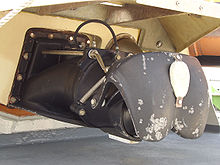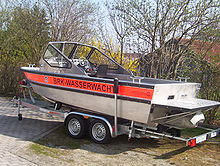Water jet propulsion
A water jet propulsion (also Pumpjetantrieb , pump jet propulsion , jet propulsion , waterjet propulsion system ) is a drive unit with reaction engine for high speeds, in special ships and for rescue units and in the recreational marine environment, especially here in the jet skis , but also in amphibious military vehicles. An impeller - a jacketed propeller - is driven by high- speed and light petrol or diesel engines or gas turbines , which sucks in water under the fuselage and ejects it again via movable nozzles at the stern.
The water jet propulsion is not to be confused with the nozzle ring propeller , a propulsion system of some modern submarines and torpedoes.
Function and comparison to the conventional drive

The water jet drive enables efficient vector control by swiveling the “movable nozzle ” in the direction the vehicle is to turn. If the water jet emerges to port , the watercraft turns to port. If the nozzle is turned so that the water jet emerges to starboard , the vehicle turns to starboard.
It is driven backwards by thrust reversing flaps on the outlet nozzle , which deflect the water jet forward and down. That the steering nozzle is not destroyed in the process and / or that the water jet shot down towards the front does not get into the water inlet of the jet drive and reduce the efficiency to zero is solved differently by each manufacturer.
Compared to the classic propeller-driven watercraft, watercraft with jet propulsion can be built and operated extremely flat and are extremely manoeuvrable even at the slowest speed.
The cavitation will occur at a much higher flow rates than a one open to propeller, since the pressure conditions which an impeller in a jet propulsion on the leaf pump sector.
This leads to the fact that the operation of a jet drive causes significantly less vibration and noise than that of a conventional drive system. Another advantage of the jet drive is that in heavy seas, the thrust does not have to be reduced if the nozzle suddenly comes out of the water due to a wave lift, as long as the water intake opening can draw enough water. In contrast, this effect can damage or even destroy a conventional drive if the drive turns too high due to the sudden lack of water resistance. A watercraft with a jet drive can therefore travel significantly faster in heavy seas than a comparable one with a conventional drive.
The US yacht manufacturer Hinckley, which builds some of its boats with both jets and wave systems, has found out during tests that in bad weather a boat with a jet drive reaches its maximum speed at almost twice the speed of a conventionally powered boat of the same size. This is completely independent of whether two boats with multiple propulsion systems or with single propulsion systems are compared with one another.
In addition, a boat with one or more jet propulsion systems can run dry without having to take the propulsion system into account, i.e. stranded on the bottom in a tidal area at low tide, while if a conventionally powered boat falls dry or runs aground, the propulsion system and controls in particular are at risk of breaking .
Living things in the water such as people, birds or fish are not endangered by a jet drive, while contact with a rotating propeller can cause serious or fatal injuries. A swimmer from a jet-propelled boat is only threatened by a collision with the hull or keel and by the possibility of being pushed underwater.
These are the main reasons why jet drives are becoming more and more widespread, especially outside Germany, in pilot and rescue companies, but also in the police, customs and coast guard organizations, and are gradually replacing pilot transfer boats, sea rescue vehicles, police, customs and coast guard boats with conventional drives.
History and property rights

As early as 1866 there was an experimental armored ship, the HMS Waterwitch , which was equipped with a water jet drive. The Gustav Zeuner chain steamer was also equipped with a water jet drive as early as 1895 . A thrust reversal had also already been implemented there.
In 1954, the New Zealander Sir William Hamilton developed the invention of the centrifugal pump by the American Hanley into a horizontal pump . The demand was so great early on that Hamilton granted licenses to replicate the jet drives. In principle, anyone can now (re) build it, as the property right of the patent has expired.
The question of vector control and thrust reversal is considered complicated and is treated differently by each manufacturer. Patents on this end of jet propulsion are still valid. The picture above shows the principle, which is similar to the thrust reversal of an aircraft engine.
Another problem under patent law arises at the intake port of the jet drive, where the shape of the diffuser influences the flow behavior. There are various patents for the high-speed sector.
The water jet propulsion systems from Kongsberg Maritime, originally Rolls-Royce Commercial Marine, or previously KaMeWa ( Karlstads Mekaniska Werkstad ) deliver the highest speeds. The company is building what is currently the largest functioning jet propulsion system, which is powered by a 36 MW gas turbine and has an internal diameter of around three meters.
Distribution, efficiency and sizes
In the meantime, jet propulsion has also found its way into recreational / sport shipping. Once it is used in jet skis , where avoiding the risk of swimmers and the compact design for easy transport are essential.

Outboard motor manufacturers now also have the jet drive in their range, although it works differently there, as it can only be implemented as a centrifugal pump integrated in the underwater part . Such jet drive outboard motors are controlled by moving the motor in its suspension on the transom of the boat.
The efficiency of a jet drive, be it an outboard or a classic inboard drive, is always slightly worse than that of a conventional propulsion system. Compared to conventional multi-propeller drives, only multiple systems with several jets per boat are economical, since the multiple system operation with conventional drives reduces the overall efficiency of a boat / ship with each additional propeller shaft, which is not the case with jet drives. Depending on the type and construction of the boat as well as the intended use, a multi-jet system is equivalent in terms of overall efficiency to a multi-shaft system with two to three units per boat.
Jet propulsion can even be found on board sailing boats / ships, as it is possible to sail when the propulsion system is switched off without a propeller or folding propeller in the water having an unfavorable effect on the course of the flow and thus on the water resistance and the sailing properties.
The smallest functional jet drive with an inner diameter of just under one centimeter is currently being manufactured by the Graupner company for ship model building . Despite its small size, it has a thrust reverser and vector control. The jets from Kehrer Modellbau are also widespread in the model making sector , but Harztec Modellbau also offers small, powerful jet drives.
Individual evidence
- ^ Journal of the Franklin Institute . Pergamon Press, 1866 ( google.de [accessed December 1, 2019]).
- ^ The New York Times: The Hydraulic Propeller. published on January 13, 1868 ( PDF, 365 kB )
- ↑ Steel waterjets - Kongsberg Maritime. Accessed December 1, 2019 .


